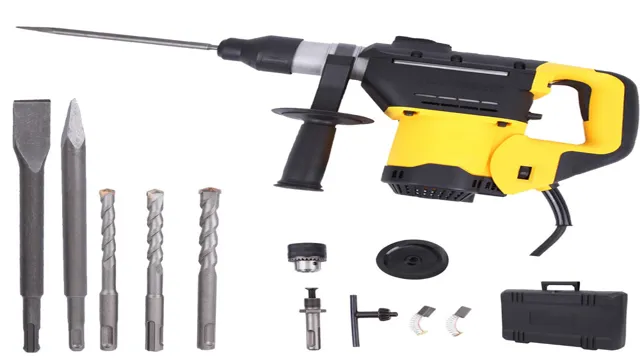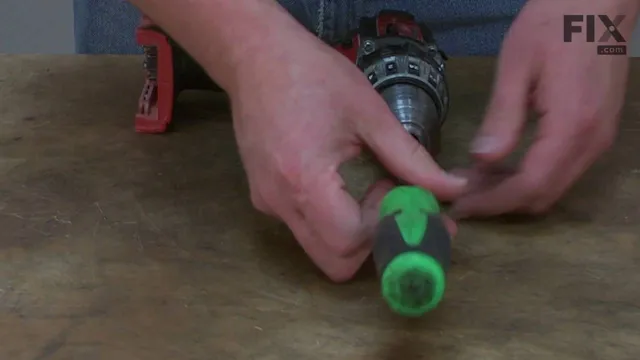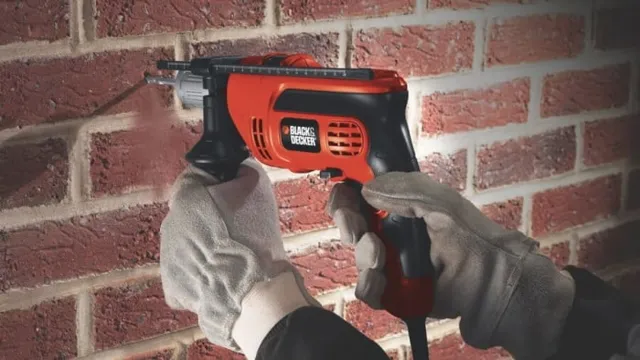Can You Use a Hammer Drill as a Chisel? Tips and Precautions.
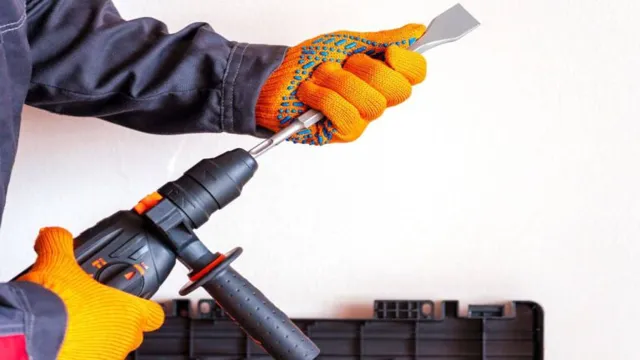
Have you ever looked at a chipped off tile or a stubborn piece of concrete sticking out of your floor and wondered how to remove it without breaking a sweat? Well, fear not, for the tool you need is probably already sitting in your toolbox! A hammer drill can be an incredibly handy tool to use as a chisel, and can save you a lot of time and effort when it comes to removing unwanted materials. While it may seem counterintuitive to use a drill as a chisel, the reality is that hammer drills are designed to deliver powerful, rapid impacts that can easily break up tough materials. By attaching a chisel bit to your hammer drill, you can use the impact power to chip away at tiles, concrete, or other materials, without having to use excessive force or damage your subflooring.
Of course, using a hammer drill as a chisel requires a bit of technique and practice to get the hang of it. But once you’ve got the basics down, it can be a game-changer for any DIY project that involves excavation or demolition. So why not give it a try and see how easy it is to use your trusty hammer drill in a whole new way? Get ready to watch those pesky tiles and concrete slabs crumble before your eyes!
What is a Hammer Drill?
A hammer drill is a versatile power tool that combines hammering and drilling actions, making it ideal for tough materials like masonry and concrete. But can you use a hammer drill as a chisel? The answer is, it depends. While some hammer drills can come with chisel attachments that allow it to be used as a chisel, not all hammer drills are designed for this purpose.
Moreover, using a hammer drill as a chisel can be dangerous and potentially damage the tool. It’s best to use a dedicated chisel or chisel attachment for hammer drills, which are designed specifically for this purpose. In short, if you’re looking to chisel with a hammer drill, make sure you have the right equipment, and don’t try to make do with just the drill.
It’s safer and more effective to use the right tool for the job.
Description of a Hammer Drill
A hammer drill is a powerful tool that is specifically designed to drill through tough surfaces, such as concrete, stone, or brick. A hammer drill works by combining a rapid, spinning motion with a hammering action, which allows it to break through hard materials quickly and effectively. This type of drill is commonly used by construction workers, DIY enthusiasts, and homeowners who need to create holes in unforgiving materials.
What sets a hammer drill apart from a regular drill is its internal mechanism. While a regular drill has a motor that simply rotates the drill bit, a hammer drill has an addition mechanism that creates a forward and backward motion. This motion, combined with the drill’s spinning action, creates a hammering effect that helps to break apart tough materials.
There are two main types of hammer drills: corded and cordless. Corded hammer drills are typically more powerful and can handle heavy-duty tasks, while cordless models are more portable and convenient for smaller projects. Some hammer drills also come with additional features, such as adjustable speeds and depth stops to help users drill accurately.
In summary, a hammer drill is an essential tool for anyone who needs to drill through concrete or other hard materials. By combining a hammering action with a spinning motion, a hammer drill makes it possible to create holes quickly and efficiently, even in unforgiving surfaces.
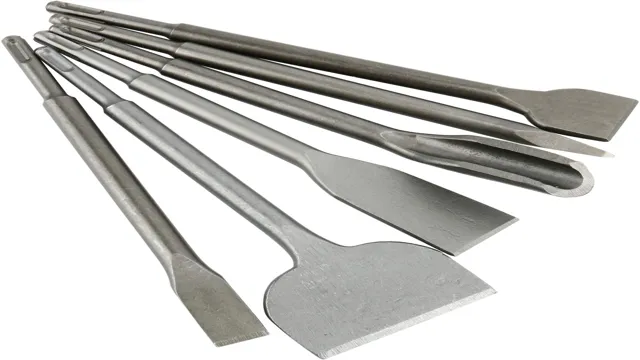
What is a Chisel?
A chisel is a hand tool used for cutting, shaping, and carving hard materials like wood, metal, or stone. It typically consists of a sharp metal blade with a handle. You can’t use a hammer drill as a chisel.
Although both tools look somewhat similar, they serve different purposes. A hammer drill is a power tool used for drilling holes in hard materials like concrete or masonry. It uses a rotary motion and percussive force to penetrate the surface.
In contrast, a chisel is used for removing material, not drilling holes. The blade of a chisel is designed to strike the material at a specific angle to create a cutting edge. This is different from a hammer drill, which uses a bit to bore through the surface.
So, using a hammer drill as a chisel is not recommended because it can damage the tool and cause injury. It’s important to use the right tool for the job to avoid accidents and achieve the desired result efficiently.
Description of a Chisel
A chisel is a woodworking tool that is primarily used for carving and shaping wood, stone, or metal. It consists of a sharp blade made of steel, which is attached to a handle made of wood or plastic. The blade is typically narrow and flat, and it has a sharp edge that is beveled on one side.
The handle of a chisel is designed to fit comfortably into the hand of the user, and it provides a secure grip that allows for precise control over the tool. Chisels come in a variety of shapes and sizes, including straight blades, curved blades, and V-shaped blades. Each type of chisel is designed for specific tasks, such as carving intricate designs or cutting through dense materials like stone or metal.
Some chisels also feature specialized blades, such as gouges or fishtail chisels, which are used for more advanced carving techniques. Overall, a chisel is an essential tool for any woodworker or artisan who wants to create beautiful, intricate designs that showcase the natural beauty of the materials they are working with.
Can You Use a Hammer Drill as a Chisel?
Can you use a hammer drill as a chisel? While a hammer drill is primarily designed for drilling, it can also be used as a chisel. However, it’s important to note that using a hammer drill as a chisel may not provide the same precision and accuracy as using a traditional chisel. If you’re going to use a hammer drill as a chisel, make sure to use a chisel bit and set your drill to chiseling mode.
This will ensure that the bit doesn’t spin, and instead moves forward and backward to chisel away at your material. It’s also recommended that you only use a hammer drill as a chisel on softer materials, like wood or plaster, as using it on harder materials, like concrete or stone, may cause damage to the drill bit.
Pros and Cons of Using a Hammer Drill as a Chisel
Using a hammer drill as a chisel can be a time-saving hack for those who want to perform multiple tasks with a single tool. However, it is important to know that there are both pros and cons to using a hammer drill as a chisel. One of the advantages of using a hammer drill as a chisel is that it can save time and money by eliminating the need to purchase an additional chisel.
Additionally, hammer drills are known for their power and speed which can make them ideal for tough materials such as concrete or stone. However, the downsides of using a hammer drill as a chisel outweigh the benefits. Firstly, using a hammer drill as a chisel can cause damage to the tool, reducing its lifespan significantly.
Secondly, the accuracy of the chiseling is compromised as hammer drills are not designed for precision work. This can lead to uneven and rough edging which cannot be achieved through the use of traditional chisels. Overall, while using a hammer drill as a chisel may seem like an attractive option, it is not recommended due to its associated drawbacks.
It’s best to invest in a high-quality chisel when precision and accuracy are required.
Safety Considerations
Safety Considerations: Can You Use a Hammer Drill as a Chisel? Using a hammer drill as a chisel might seem like a good idea, but it’s not recommended for safety reasons. A hammer drill is designed to create holes in concrete, brick, and other hard materials with a hammering motion that uses rapid impacts to break up the surface. On the other hand, a chisel is used to remove material in a controlled manner by hand pressure, and it requires a different tool altogether.
Attempting to use a hammer drill as a chisel can damage the drill bit and the material being chiseled, and it can also be hazardous to the operator. If the bit becomes defective or breaks off, it can cause flying debris and injure anyone in the vicinity. Therefore, it’s important to use the right tool for the job and follow the manufacturer’s instructions to prevent any accidents.
Although it may seem like a shortcut to use a hammer drill as a chisel, the risks are too great to be worth it. Play it safe and use the right tool for the job.
How to Use a Hammer Drill as a Chisel
If you’re wondering if you can use a hammer drill as a chisel, the answer is yes! However, it’s important to note that a hammer drill is not specifically designed for chiseling, so the results may not be as precise as using an actual chisel. To use a hammer drill as a chisel, you will need a chisel bit that can be inserted into the drill chuck. Once you have the bit attached, you can use the hammer drill to chip away at tough materials such as concrete or stone.
It’s important to take safety precautions such as wearing goggles and gloves as the chipping process can create flying debris. It’s also important to use the correct speed setting on the hammer drill to ensure maximum efficiency and accuracy. Overall, while a hammer drill can be used as a makeshift chisel, it’s recommended to use an actual chisel for more precise results.
Step-by-Step Instructions
Using a hammer drill as a chisel might seem like a daunting task, but it’s actually quite simple with the right tools and technique. First, you’ll need a chisel bit that fits your hammer drill. You should also make sure to wear proper safety gear, such as goggles and gloves, to protect yourself from flying debris.
Once you have everything in place, it’s time to start chiseling. To begin, attach the chisel bit to your hammer drill, making sure it’s securely in place. Then, hold the drill at a slight angle and press it lightly against the surface you want to chisel.
Make sure to move the drill back and forth in a steady, controlled motion to create a clean and precise chisel mark. If you’re working on a particularly tough surface, you may need to apply more pressure or use a more powerful drill. But whatever you do, make sure to take breaks as needed to avoid overexerting yourself.
And if you’re not comfortable using a hammer drill as a chisel, don’t hesitate to seek out professional help. Overall, using a hammer drill as a chisel can be a useful technique for a variety of DIY projects. Just make sure to follow the proper safety precautions and techniques to avoid injury and achieve the best results possible.
Conclusion
In conclusion, attempting to use a hammer drill as a chisel is like trying to use a sandwich as a hammer – it’s just not going to work the way it’s intended. Sure, both a hammer drill and a chisel are tools used for drilling and carving into materials, but they serve different purposes and require different equipment to do the job well. So save yourself the headache (and possible injury) and use the right tool for the right job – your DIY projects (and fingers) will thank you.
FAQs
What is a hammer drill?
A hammer drill is a power tool that is used for drilling into hard surfaces such as concrete, masonry, and stone.
Can a hammer drill be used as a chisel?
No, a hammer drill cannot be used as a chisel. Although it may look similar to a chisel, a hammer drill is not designed for chiseling tasks.
Can you use a chisel with a hammer drill?
No, you should not use a chisel with a hammer drill. Hammer drills are designed to drill holes into hard surfaces, but they are not suitable for chiseling tasks.
What is the difference between a hammer drill and a chisel?
A hammer drill is designed for drilling while a chisel is designed for chiseling or carving. Although they may look similar, they are different tools with different purposes.
What are the safety precautions when using a hammer drill?
When using a hammer drill, you should always wear protective gear such as safety glasses, a dust mask, and earplugs. You should also make sure to secure the workpiece and keep your hands and the drill bit away from any moving parts.
Can a hammer drill be used on wood?
Yes, a hammer drill can be used on wood, but it is not the best tool for the job. A regular drill with a wood bit is more suitable for woodworking.
Can a chisel be used on concrete?
Yes, a chisel can be used on concrete, but it requires a lot of force and is not very efficient. A hammer drill with a chisel bit is a better option for working with concrete.

